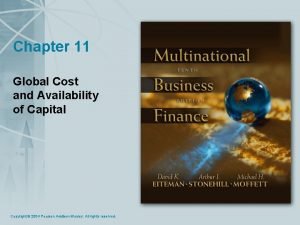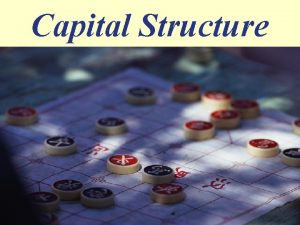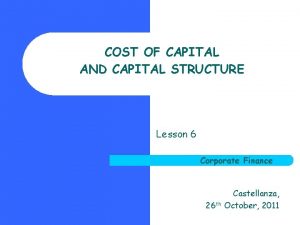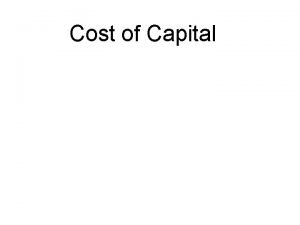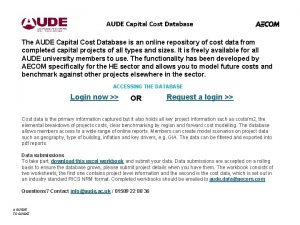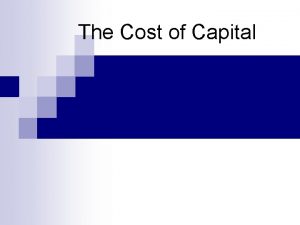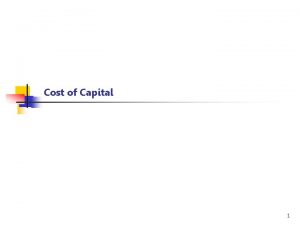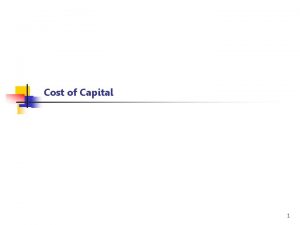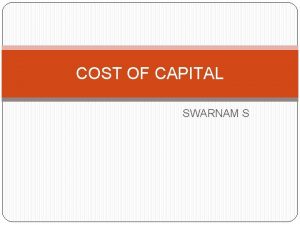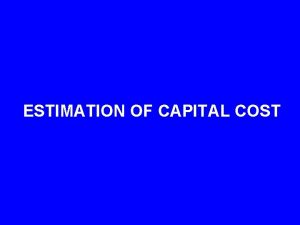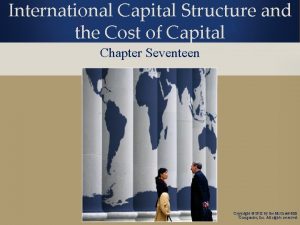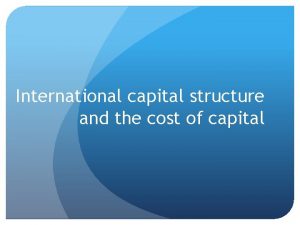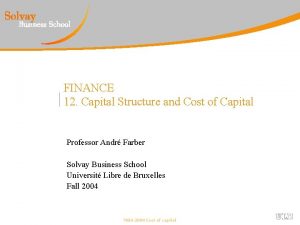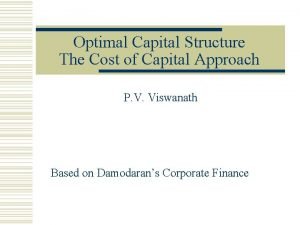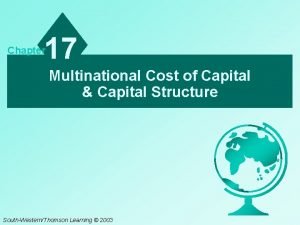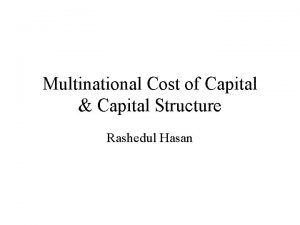COST OF CAPITAL AND CAPITAL STRUCTURE Lesson 6




















- Slides: 20

COST OF CAPITAL AND CAPITAL STRUCTURE Lesson 6 Corporate Finance Castellanza, 13 th October, 2010 Corporate Finance

Cost of capital Def: is the expected rate of return that the market requires in order to attract funds to a particular investment. (cost of capital/rate of return) Characteristics: • it is market driven • it is forward-looking • it is usually measured in nominal terms (including expected inflation) Capital refers to the components of a capital structure: debt and equity Corporate Finance

Cost of equity (Ke) indirect way (CAPM) opportunity cost: the cost of foregoing the next best alternative investment at a specific level of risk Ke = rf+ P rf = free risk return P = premium Corporate Finance

Cost of debt (Kd) Kd = i( 1 -t ) i = interest rate t = tax rate of the company (interests are taxdeductible expenses) Kd = f. interest rate bankruptcy risk tax benefits Corporate Finance

Weighted average cost of capital (WACC) To be used when the objective is to value the entire capital structure of a company. WACC = [Ke E/(E+D)] + [Kd D/(E+D)] E = equity, D = net financial debt or Net Financial Position Ke > WACC > Kd Corporate Finance

Capital structure Def: the capital structure of a firm is broadly made up of its amounts of equity and debt Components: equity (shareholder’s equity, corporate reserves, earnings) debt (ST and LT debts, corporate bonds, commercial papers …) quasi-equity (convertible bonds, mezzanine financing) Corporate Finance

Capital structure (cont’d) Debt versus Equity Fixed claims High priority on cash flows Tax deductible Fixed Maturity No management control Residual claims Lowest priority on cash flows No tax deductible Infinite life Management control _______________________ Debt Hybrids (Quasi-equity) Corporate Finance Equity

Capital structure – costs and benefits of debt (cont’d) Benefits of debt ü Tax benefits when you borrow money, you are allowed to deduct interest expenses from your income to arrive a taxable income. This reduces your taxes. When you use equity you are not allowed to deduct payments to equity (such as dividends) to arrive at taxable income ü Adds discipline to management if you are manager of a firm with no debt, and you generate high income and cash flows each year, you tend to become complacent. The complacency can lead to inefficiency and investing in poor projects Costs of debt ü Bankruptcy costs ü Agency costs ü Loss of future flexibility Corporate Finance

The financing mix question In deciding to raise financing for a business, is there an optimal mix of debt and equity? If yes What is the trade-off that let us determine the optimal mix? Corporate Finance

Maximization of shareholders’ return (ROE) If: taxes = 0 and extraord. rev. -exp. = 0 ROE = [ROI + (D/E) * (ROI – i)] ROI = EBIT CI ROE = i = Interests expenses Net Debt E = Equity D = Net Debt or Net Financial Position CI = Capital invested = D + E i = interest rate paid on Net Debt Corporate Finance Net profit E Leverage = D E

Relationship between ROE and ROI (cont’d) Considering taxes: ROE = [ROI + (D/E) * (ROI – i)] * (1 -t) t = tax rate (taxes/EBT) Considering extraordinary revenues/expenses: ROE = [ROI + (D/E) * (ROI – i)] * (1 -t) * (1 -s) s = (net extraordinary rev. -exp. /earnings before net extraordinary rev. -exp. ) Corporate Finance

Relationship between ROE and ROI : Example Corporate Finance

Relationship between ROE and ROI : Example ROE = [ ROI + ( D / E ) * ( ROI – i) ] * (1 – t) ROE = [11, 2% + (12. 000/10. 300) * (11, 2% – 5, 0%)] * (1 -31, 6%) ROE = [11, 2% + (1, 17) * (6, 2%)] * (68, 4%) ROE = [11, 2% + 7, 2%] * (68, 4%) ROE = 18, 4% * 68, 4% = 12, 6% Corporate Finance

Relationship between ROE and ROI Decrease ROE Decrease self-financing Increase cost of debt Increase of debt 14 Corporate Finance

Leverage = D / E D = total financial debt or Net Financial Position E = equity Using leverage it is possible to increase debt in order to increase return on equity ü ü ü D/E = 1 D/E > 1 D/E < 1 neutral situation to monitor situation to exploit 15 Corporate Finance

Modigliani – Miller theory Hp: in an environment where there are no taxes, bankruptcy risk or agency costs (no separation between stockholders and managers), capital structure is irrelevant. the value of a firm (V) is independent of its debt ratio (D/E). The cost of capital of the firm will not change with leverage. V Va D/E Corporate Finance

Modigliani – Miller theory (cont’d) The effect of taxes V Vi =Vu + Vats Vi Vi = value of levered firm Vu = value of unlevered firm Va Vats = actual value of tax shields D/E Corporate Finance

Trade-off theory The effect of bankruptcy costs V Vi Value of levered firms without bankruptcy costs Vabc Vl Value of levered firms Vl = Vu+Vats-Vabc Vats Vu Value of unlevered firms D/E Vabc = actual value of bankruptcy costs Vats = actual value of tax shields Corporate Finance

Picking order theory Internal Financing sources External 1. Self-financing 2. Debt 3. Increase of equity Profitability Net Debt Level Corporate Finance

Financing mix decision 1. Macroeconomic context (capital markets) 2. Industry (maturity, capex, risk, etc. ) 3. Firm’s characteristics (market position, financial-economic situation…) 4. Financial needs’ characteristics Corporate Finance
 Multinational capital structure
Multinational capital structure Multinational cost of capital and capital structure
Multinational cost of capital and capital structure Cost accumulation and cost assignment
Cost accumulation and cost assignment Cost accumulation and cost assignment
Cost accumulation and cost assignment Cost pools
Cost pools What is a period cost on the income statement
What is a period cost on the income statement Cost control and cost reduction difference
Cost control and cost reduction difference Standard cost accounting
Standard cost accounting Distinguish between average cost and marginal cost
Distinguish between average cost and marginal cost Cost control and cost reduction difference
Cost control and cost reduction difference Process and job order operations are similar in that both
Process and job order operations are similar in that both Ordering cost and carrying cost
Ordering cost and carrying cost Opportunity costs and trade offs
Opportunity costs and trade offs Cost control and cost reduction project report
Cost control and cost reduction project report Cost control and cost reduction project report
Cost control and cost reduction project report Cost behavior and cost-volume-profit analysis
Cost behavior and cost-volume-profit analysis The international availability of capital to mnes
The international availability of capital to mnes Introduction of working capital
Introduction of working capital Difference between capital reserve and reserve capital
Difference between capital reserve and reserve capital Difference between capital reserve and reserve capital
Difference between capital reserve and reserve capital Variable capital examples
Variable capital examples
















